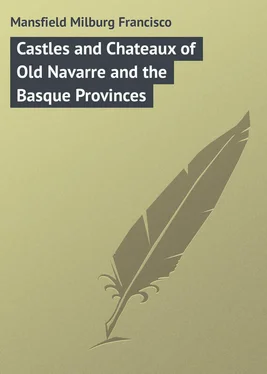Milburg Mansfield - Castles and Chateaux of Old Navarre and the Basque Provinces
Здесь есть возможность читать онлайн «Milburg Mansfield - Castles and Chateaux of Old Navarre and the Basque Provinces» — ознакомительный отрывок электронной книги совершенно бесплатно, а после прочтения отрывка купить полную версию. В некоторых случаях можно слушать аудио, скачать через торрент в формате fb2 и присутствует краткое содержание. ISBN: , Жанр: foreign_prose, на английском языке. Описание произведения, (предисловие) а так же отзывы посетителей доступны на портале библиотеки ЛибКат.
- Название:Castles and Chateaux of Old Navarre and the Basque Provinces
- Автор:
- Жанр:
- Год:неизвестен
- ISBN:http://www.gutenberg.org/ebooks/43609
- Рейтинг книги:4 / 5. Голосов: 1
-
Избранное:Добавить в избранное
- Отзывы:
-
Ваша оценка:
- 80
- 1
- 2
- 3
- 4
- 5
Castles and Chateaux of Old Navarre and the Basque Provinces: краткое содержание, описание и аннотация
Предлагаем к чтению аннотацию, описание, краткое содержание или предисловие (зависит от того, что написал сам автор книги «Castles and Chateaux of Old Navarre and the Basque Provinces»). Если вы не нашли необходимую информацию о книге — напишите в комментариях, мы постараемся отыскать её.
Castles and Chateaux of Old Navarre and the Basque Provinces — читать онлайн ознакомительный отрывок
Ниже представлен текст книги, разбитый по страницам. Система сохранения места последней прочитанной страницы, позволяет с удобством читать онлайн бесплатно книгу «Castles and Chateaux of Old Navarre and the Basque Provinces», без необходимости каждый раз заново искать на чём Вы остановились. Поставьте закладку, и сможете в любой момент перейти на страницу, на которой закончили чтение.
Интервал:
Закладка:
Almost the whole range of architectural display is seen here between the Mediterranean and the Gulf of Gascony, and any rambling itinerary laid out between the two seas will discover as many structural and decorative novelties as will be found in any similar length of roadway in France.
Leaving the purely ecclesiastical edifices – cathedrals and great churches – out of the question, the entire Midi of France, and the French slopes and valleys of the Pyrenees in particular, abounds in architectural curiosities which are marvels to the student and lover of art.
There are châteaux , chastels and chastillons , one differing from another by subtle distinctions which only the expert can note. Then there are such feudal accessories as watch-towers, donjons and clochers , and great fortifying walls and gates and barbicans, and even entire fortified towns like Carcassonne and La Bastide. Surely the feudality, or rather its relics, cannot be better studied than here, – “where the people held the longest aloof from the Crown.”
The watch-towers which flank many of the valleys of the Pyrenees are a great curiosity and quandary to archæologists and historians. Formerly they flashed the news of wars or invasions from one outpost to another, much as does wireless telegraphy of to-day. Of these watch-towers, or tours télégraphiques , as the modern French historians call them, that of Castel-Biel, near Luchon, is the most famous. It rises on the peak of a tiny mountain in the valley of the Pique and is a square structure of perhaps a dozen or fifteen feet on each side. Sixteen feet or so from the ground, on the northwest façade, is an opening leading to the first floor. This tower is typical of its class, and is the most accessible to the hurried traveller.
The feudal history of France is most interesting to recall in this late day when every man is for himself. Not all was oppression by any means, and the peasant landowner – as distinct from the vilain and serf – was a real person, and not a supposition, even before the Revolution; though Thomas Carlyle on his furzy Scotch moor didn’t know it.
Feudal France consisted of seventy thousand fiefs or rere-fiefs, of which three thousand gave their names to their seigneurs. All seigneurs who possessed three châtellenies and a walled hamlet ( ville close ) had the right of administering justice without reference to a higher court. There were something more than seven thousand of these villes closes , within which, or on the lands belonging to the seigneurs thereof, were one million eight hundred and seventy-two thousand monuments, – churches, monasteries, abbeys, châteaux, castles, and royal or episcopal palaces. It was thus that religious, civic and military architecture grew side by side and, when new styles and modifications came in, certain interpolations were forthwith incorporated in the more ancient fabrics, giving that mélange of picturesque walls and roofs which makes France the best of all lands in which to study the architecture of mediævalism. Among these mediæval relics were interspersed others more ancient, – Roman and Greek basilicas, temples, baths, arenas, amphitheatres and aqueducts in great profusion, whose remains to-day are considerably more than mere fragments.
The hereditary aristocracy of France, the rulers and the noblesse of the smaller kingdoms, dukedoms and countships, were great builders, as befitted their state, and, being mostly great travellers and persons of wealth, they really surrounded themselves with many exotic forms of luxury which a more isolated or exclusive race would never have acquired. There is no possible doubt whatever but that it is the very mixture of styles and types that make the architecture of France so profoundly interesting even though one decries the fact that it is not national .
One well recognized fact concerning France can hardly fail to be reiterated by any who write of the manners and customs and the arts of mediæval times, and that is that the figures of population of those days bear quite similar resemblances to those of to-day. Historians of a hundred years back, even, estimated the total population of France in the fifteenth century as being very nearly the same as at the Revolution, – perhaps thirty millions. To-day eight or perhaps ten millions more may be counted, but the increase is invariably in the great cities, Paris, Lyons, Marseilles, Bordeaux, Rouen, etc. Oloron and Orthez in Béarn, Saint-Jean-Pied-de-Port in Navarre, or Agde or Elne in Roussillon, remain at the same figure at which they have stood for centuries, unless, as is more often the case, they have actually fallen off in numbers. And still France is abnormally prosperous, collectively and individually, so far as old-world nations go.
Originally the nobility in France was of four degrees: the noblesse of the blood royal, the haute-noblesse , the noblesse ordinaire and the noblesse who were made noble by patent of the ruling prince. All of these distinctions were hereditary, save, in some instances, the noblesse ordinaire .
In the height of feudal glory there were accredited over four thousand families belonging to the ancienne noblesse , and ninety thousand familles nobles (descendant branches of the above houses) who could furnish a hundred thousand knightly combatants for any “little war” that might be promulgated.
Sometimes the family name was noble and could be handed down, and sometimes not. Sometimes, too, inheritance was through the mother, not the father; this was known as the noblesse du ventre . A foreign noble naturalized in France remained noble, and retained his highest title of right.
The French nobles most often took their titles from their fiefs, and these, with the exception of baronies and marquisats , were usually of Roman origin. The chief titles below the noblesse du sang royal were ducs , barons , marquis , comtes , vicomtes , vidames , and chevaliers and each had their special armorial distinctions, some exceedingly simple, and some so elaborate with quarterings and blazonings as to be indefinable by any but a heraldic expert.
The coats of arms of feudal France, or armoiries , as the French call them (a much better form of expression by the way), are a most interesting subject of study. Some of these armoiries are really beautiful, some quaint and some enigmatic, as for instance those of the King of Navarre.
The Revolutionary Assembly abolished such things in France, but Napoleon restored them all again, and created a new noblesse as well:
“Aussitôt maint esprit fécond en reveries,
Inventa le blason avec les armoiries.”
sang the poet Boileau.
Primarily armoiries were royal bequests, but in these days a pork-packer, an iron-founder or a cheese-maker concocts a trade-mark on heraldic lines and the thing has fallen flat. Fancy a pig sitting on a barrel top and flanked by two ears of corn, or a pyramid of cheeses overtopped by the motto “A full stomach maketh good health.” Why it’s almost as ridiculous as a crossed pick-axe, a shovel and a crow-bar would be for a navvy on a railway line! In the old days it was not often thus, though a similar ridiculous thing, which no one seemed to take the trouble to suppress, was found in the “ Armoiries des gueux .” One of these showed two twists of tobacco en croix , with the following motto: “ Dieu vous bénisse !”
At the head of the list of French armoiries were those of domain or souveraineté .
Then followed several other distinct classes. “ Armoiries de Pretention ,” where the patronal rights over a city or a province were given the holders, even though the province was under the chief domination of a more powerful noble.
Читать дальшеИнтервал:
Закладка:
Похожие книги на «Castles and Chateaux of Old Navarre and the Basque Provinces»
Представляем Вашему вниманию похожие книги на «Castles and Chateaux of Old Navarre and the Basque Provinces» списком для выбора. Мы отобрали схожую по названию и смыслу литературу в надежде предоставить читателям больше вариантов отыскать новые, интересные, ещё непрочитанные произведения.
Обсуждение, отзывы о книге «Castles and Chateaux of Old Navarre and the Basque Provinces» и просто собственные мнения читателей. Оставьте ваши комментарии, напишите, что Вы думаете о произведении, его смысле или главных героях. Укажите что конкретно понравилось, а что нет, и почему Вы так считаете.












